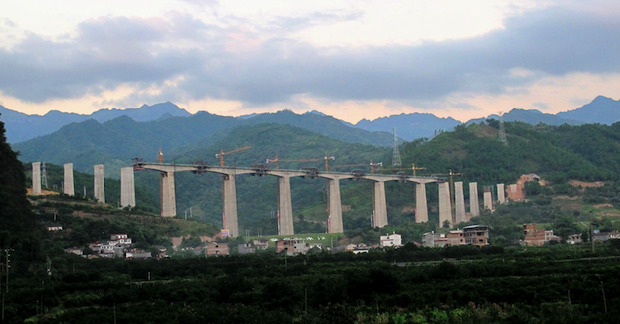One Belt One Road: Opportunities for Australia

The One Belt One Road Initiative is gaining more and more attention within China and in the world. China has huge ambitions for the initiative and is devoting significant effort to its goals. At the national level, China put forward the Vision and Actions on Jointly Building Silk Road Economic Belt and 21st Century Maritime Silk Road in March 2015. This document offers a blueprint for an ambitious development strategy.
At the provincial level, Chinese governments have developed their own action plans to further implement projects under the initiative. China is backing the plan with considerable resources, setting up a New Silk Road Fund of US$40 billion (A$52 billion). In addition, the Asian Infrastructure Investment Bank is widely expected to support OBOR with a considerable share of its US$100 billion in lending.
Although Australia is not physically located on the Belt and Road, China has claimed in multiple occasions that the initiative is inclusive and open to any countries who are interested in participating. Chinese president Xi Jinping has stated that developing northern Australia has huge potential to link with the Belt and Road Initiative. Andrew Robb, former federal minister for trade and investment, has also commented that as Australia’s largest and one of the most important trading and investment partners, China’s Belt and Road Initiative provides a platform for both countries to reinforce existing economic strengths.
The opportunities for Australia lie in three areas: China’s investment in Australia, Australia’s investment in China, and the opportunities for Australian industries in third countries. There could be significant economic benefits to Australia through the opening up of investment opportunities.
Belt and Road Initiative projects will be many and varied, but will have an early focus on infrastructure. Implementation over the long-term will require substantial skills in sectors in which Australia has recognised global strengths, including infrastructure, energy and resources, advanced manufacturing, education and banking and finance.
As the initiative is still in its formative stage, it is an opportune time for industry leaders, from both Australia and China, to work together to identify viable Belt and Road partnership pathways, opening up additional trade and investment opportunities over the medium to long-term. Key to determining this is:
- For Australian industry to understand the intent of the Belt and Road Initiative as well as practical examples of projects that relate to specific industry sectors and regions;
- For Chinese enterprises to understand the areas in which Australian industries have strong competitive capabilities that can have direct application to Belt and Road priority areas (both in China and participating Belt and Road countries).
The Belt and Road Initiative’s intended scale, its potential for economic transformation and intergovernmental cooperation also give rise to some key challenges that need to be understood, considered and addressed. Political uncertainty and investment risk associated with countries along the Belt and Road routes present varying degrees of risk, demonstrated by the sovereign debt of more than two thirds being either unrated or rated below investment-grade (Ba1-B3 or lower) by Moody’s Investor Service. Where there are uncertain political and regulatory environments, the ability to guarantee the enforcement of bilateral trade treaties and resolve disputes is significantly impeded—all which are critical to the success of the Belt and Road Initiative. Also, the scale of projects that will fall under the remit of the Belt and Road Initiative will be significant and complex. Without a robust, transparent and competitive project approval system, supplemented by deep industry expertise, the risk of project failure and/or considerable cost over-run is substantial.
However, those challenges should not stop Australian industries from participating in Belt and Road Initiative developments. Those challenges highlight the urgent needs for Australian industry to invest in time and effort to understand the commercial opportunities along the Belt and Road route and carefully identity their competitive advantages and strategic regional focus and project focus.
The economic opportunities are indeed great. To date Chinese investment in industrial production capacity along the Belt and Road has topped US$100bn. There are 52 projects in early-stage development between China and Kazakhstan alone amounting to more than US$27 billion of investment.
To provide a vital link for Australian industries and businesses to focus on identifying and pursuing commercial opportunities with Chinese enterprises in relation to the Belt and Road Initiative, a not-for-profit organisation called Australia-China One Belt One Road Initiative (ACOBORI) was established last year.
ACOBORI has recently published a report titled China’s Belt and Road-Opportunities for Australian Industry. This report is intended to provide representatives of Australia’s industries and professional services with a better understanding of current Belt and Road projects. It is also designed to provoke a level of wnquiry and consideration about the breadth and depth of possibilities for Australia to benefit from the implementation of the Belt and Road Initiative. To further support Australian industries’ involvement in this initiative, ACOBORI is in the process of developing the world-first Australia-China Belt and Road Engagement Framework. The purpose of this Framework is to provide leading Australian companies with a practical and useful tool and enable Australian companies to take a targeted approach to identifying and exploring specific Belt and Road project opportunities.
Jean Dong is the executive director of the Australia-China One Belt One Road Initiative (ACOBORI). Xu Wang is a research associate and Gemma Cooper is a director of ACOBORI.
This article is published under a Creative Commons Licence and may be republished with attribution.





